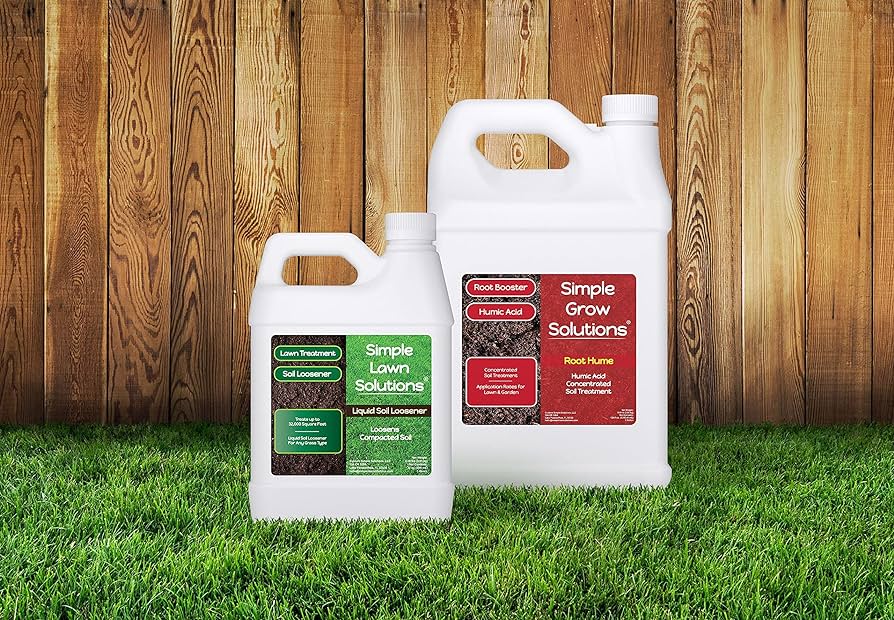Property Owner’s Quick Guide to Humic Acid for Lawns
A lush, green lawn is the pride of any homeowner. Establishing and maintaining a thriving lawn can be challenging since many factors must be considered, encompassing soil conditions, irrigation practices, and fertilizing routines. One often overlooked but incredibly beneficial component of lawn care is humic acid.
In this extensive guide, we will explore all the essential aspects of humic acid for lawns, ranging from its fundamental nature to the proficient techniques for its application, ultimately leading to the rejuvenation of your lawn into a lush and vibrant haven.
What Is Humic Acid?
Before we dive into its benefits for lawns, let’s understand what humic acid is. Humic acid is normally a naturally occurring organic substance that develops as organic matter decomposes gradually. It constitutes a crucial element of humus, the dark, organic material in soil. Humic acid is characterized by its high carbon content and comprises a complex blend of diverse organic compounds, including fulvic acid and humin.
Humic acid is commonly derived from materials such as lignite, peat, and leonardite, which originate from ancient deposits of decomposed organic matter. These sources undergo a series of chemical processes to extract and refine the humic acid, resulting in a concentrated product that can be used to improve soil quality.
The Benefits of Humic Acid for Lawns
Now that we know what humic acid is, let’s explore its numerous benefits for lawns.
1. Soil Conditioning
One of the key advantages of humic acid is its capacity to enhance soil structure and quality. When incorporated into the soil, humic acid aids in the loosening of compacted soil, increasing its porosity and facilitating improved water penetration and root development. This improved soil structure also reduces runoff and erosion, which can be particularly beneficial in areas with heavy rainfall.
2. Nutrient Retention
Humic acid functions as a natural chelator, meaning it can attach to vital nutrients such as iron, calcium, magnesium, and potassium. This binding mechanism enhances the accessibility of these nutrients to plants, effectively preventing their leaching from the soil. As a result, lawns treated with humic acid can access a steady supply of nutrients, leading to healthier and greener grass.
3. Enhanced Microbial Activity
Fertile soil harbors a wealth of advantageous microorganisms pivotal for nutrient cycling and disease control. Humic acid functions as a nutrient source for these microorganisms, nurturing their proliferation and engagement. This heightened microbial activity enhances nutrient decomposition and mineralization, ultimately bolstering the lawn’s overall vitality.
4. pH Balancing
Balancing soil pH is critical for ensuring plants can absorb nutrients effectively. Humic acid exhibits an impressive capacity to regulate soil pH, ensuring it remains within the optimal range for a variety of plants, including grass. Therefore, whether your soil is overly acidic or alkaline, humic acid can assist in adjusting it to the right equilibrium, fostering an environment where your lawn can flourish.
5. Water Retention
Humic acid also contributes to water retention. It enhances soil structure and boosts its ability to retain water, allowing lawns to endure dry spells more effectively. This can decrease the necessity for frequent watering, resulting in water and cost savings over time.
6. Reduced Soil Erosion
A humic acid lawn is less susceptible to soil erosion. The improved soil structure and increased microbial activity strengthen the root system, anchoring the grass more effectively. This, in turn, reduces the risk of soil being washed away during heavy rains or irrigation, preserving the integrity of your lawn.
7. Weed and Disease Suppression
While humic acid doesn’t directly kill weeds or pathogens, it can indirectly help in weed and disease control. By promoting healthy grass growth and improving nutrient uptake, humic acid helps lawns become more resistant to weed invasion and less susceptible to diseases.
How to Apply Humic Acid to Your Lawn:
Properly applying humic acid is crucial to maximize its benefits for your lawn. Follow the guide below:
Test Your Soil: To ensure the effectiveness of humic acid for lawns, consider conducting a soil test to establish its pH and nutrient levels. This information will help you tailor your humic acid treatment.
Choose the Right Product: Humic acid is available in various forms, such as liquid, granular, or powder. Select the form that suits your lawn size and your preferred application method.
Calculate the Application Rate: Read the product label to determine the recommended application rate for your lawn’s size and condition. This rate can vary depending on the product’s concentration.
Apply Evenly: Spread the humic acid product evenly across your lawn. For liquid forms, use a hose-end sprayer while watering the lawn. For granular or powder forms, employ a broadcast spreader for uniform distribution.
Water Thoroughly: After application, water your lawn thoroughly. This helps the humic acid penetrate the soil and start working effectively.
Repeat as Necessary: The frequency of application depends on your soil’s condition and the product used. Typically, apply humic acid 2-4 times a year, with some applications in the spring and fall for best results.
By following these steps, you can ensure that humic acid is applied correctly to your lawn, promoting healthier grass growth and improved soil quality.
Tips for Using Humic Acid Effectively:
To maximize the benefits of humic acid for your lawn, consider these valuable tips:
- Combine with Other Lawn Care Practices: Humic acid for lawns works best when integrated into a comprehensive lawn care routine. Regular mowing, aeration, and proper watering practices should complement its use.
- Be Patient: While humic acid can lead to noticeable improvements in your lawn’s health, it may take time to see significant results. Consistency in application is key, and patience will pay off.
- Monitor Your Lawn: Keep a close eye on your lawn’s condition throughout the season. Adjust your humic acid application schedule and dosage as needed based on changes in soil health and plant growth.
- Store Humic Acid Properly: If you have leftover humic acid, store it according to the manufacturer’s recommendations. Proper storage ensures the product’s effectiveness for future use.
- Consider Organic Lawn Care: If you’re interested in organic lawn care practices, humic acid aligns well with environmentally friendly approaches. It enhances soil health without relying on synthetic chemicals.
- Follow Application Guidelines: Always adhere to the product manufacturer’s recommended application rates and guidelines. Over-application can lead to nutrient imbalances or other issues in your lawn.
- Incorporate into Seasonal Lawn Care: Integrate humic acid applications into your lawn care schedule, with specific treatments in the spring and fall for optimal results during periods of active growth.
By following these tips, you can use humic acid effectively to improve your lawn’s soil structure, nutrient availability, and overall health, resulting in a greener, healthier, and more vibrant lawn.
Types of Humic Acid for Lawns:
Humic acid products for lawns come in different forms, each with its characteristics and advantages. Below are the 4 common types of humic acid for lawns:
Liquid Humic Acid: This is typically a concentrated solution that can be mixed with water and applied using a hose-end sprayer. It is known for its rapid absorption into the soil, making it an efficient choice for quick results.
Granular Humic Acid: Granular humic acid is a dry, pelletized form that can be spread using a broadcast spreader. It releases gradually into the soil, providing prolonged benefits and eliminating the need for frequent applications.
Powdered Humic Acid: This humic acid type comes in a fine, dry form that can be mixed with water and applied as a liquid solution. It offers versatility in application methods and is suitable for precise control over dosage.
Blended Products: Some humic acid products are combined with other soil amendments, such as organic matter, compost, or fertilizers. These blended products offer a comprehensive approach to lawn care, addressing multiple needs in a single application.
When choosing a type of humic acid lawn fertilizer, consider factors like your soil’s condition, the desired application method, and the convenience of use. Each type can be effective when used correctly, and your choice will depend on your specific lawn care goals and preferences.
When to Use Humic Acid for Lawns:
Timing plays an essential role in the effectiveness of humic acid lawn care. Here’s when to use it:
1. Early Spring: Apply humic acid as the soil warms up to jumpstart microbial activity, improve nutrient uptake, and promote healthy spring growth.
2. Fall: A fall application helps prepare your lawn for winter dormancy, enhancing root development and nutrient storage for a robust spring emergence.
3. After Aeration: If you’ve recently aerated your lawn, follow up with humic acid to maximize its penetration into the soil and enhance its benefits.
4. Before Overseeding: Apply humic acid lawn before overseeding or reseeding to create an optimal environment for seed germination and establishment.
5. During Stress Periods: Use humic acid during periods of stress, such as drought or extreme heat, to aid your lawn in coping with adverse conditions.
6. Regular Maintenance: Incorporate humic acid into your routine lawn care schedule to maintain soil health, improve nutrient retention, and promote lush, green grass throughout the year.
Conclusion
Humic acid is a powerful ingredient for a vibrant, healthy lawn. Its capacity to enhance soil structure, boost nutrient accessibility, and stimulate microbial activity renders it a valuable asset in any lawn care routine. By adhering to the tips and precautions provided in this guide, you can unlock the potential of humic acid to convert your lawn into a flourishing outdoor haven. Keep in mind that a well-maintained lawn not only elevates your property’s aesthetics but also offers a hospitable environment for outdoor pastimes and unwinding. Therefore, prepare to get to work, apply some humic acid, and savor the sight of a lusher, more vibrant lawn.






